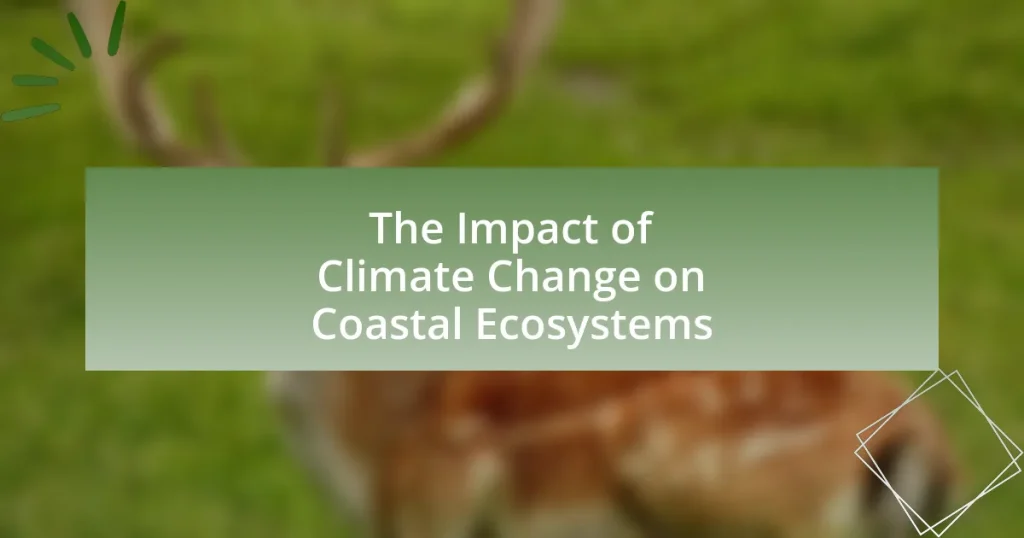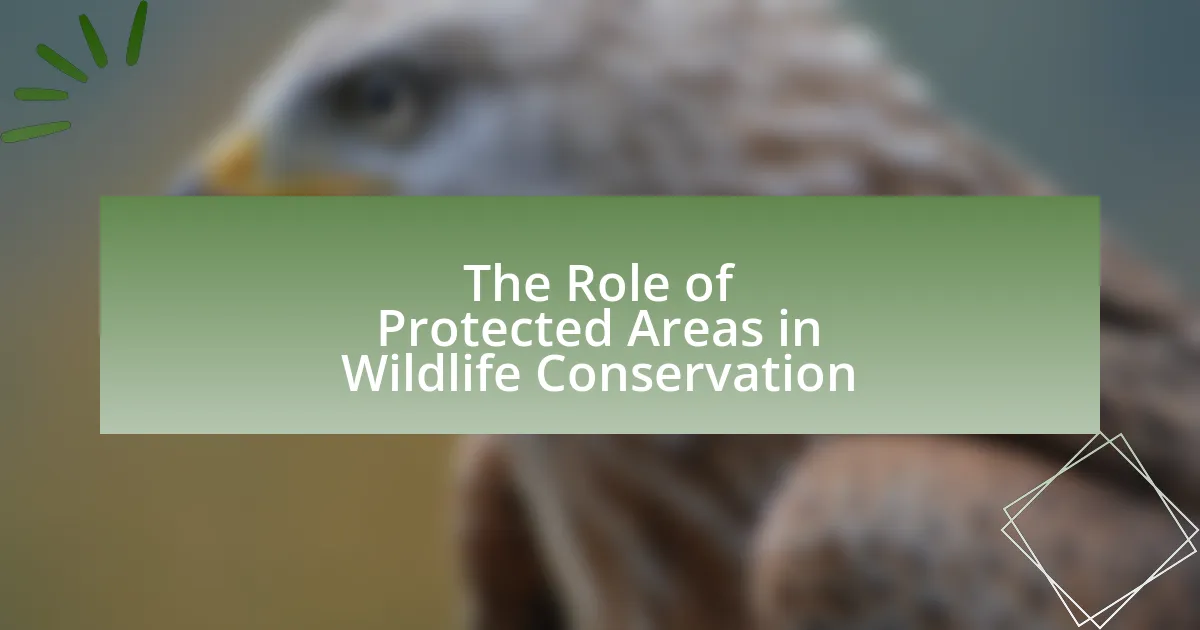The article focuses on the impact of climate change on coastal ecosystems, highlighting key factors such as rising sea levels, increased ocean temperatures, and ocean acidification. These changes threaten vital habitats like mangroves, salt marshes, and coral reefs, leading to biodiversity loss and disruptions in marine food webs. The article discusses the consequences of habitat loss, altered species distributions, and the implications for human livelihoods, emphasizing the importance of understanding these impacts for effective conservation and adaptation strategies. Additionally, it outlines potential mitigation measures, including habitat restoration and sustainable management practices, to enhance the resilience of coastal ecosystems against climate change.
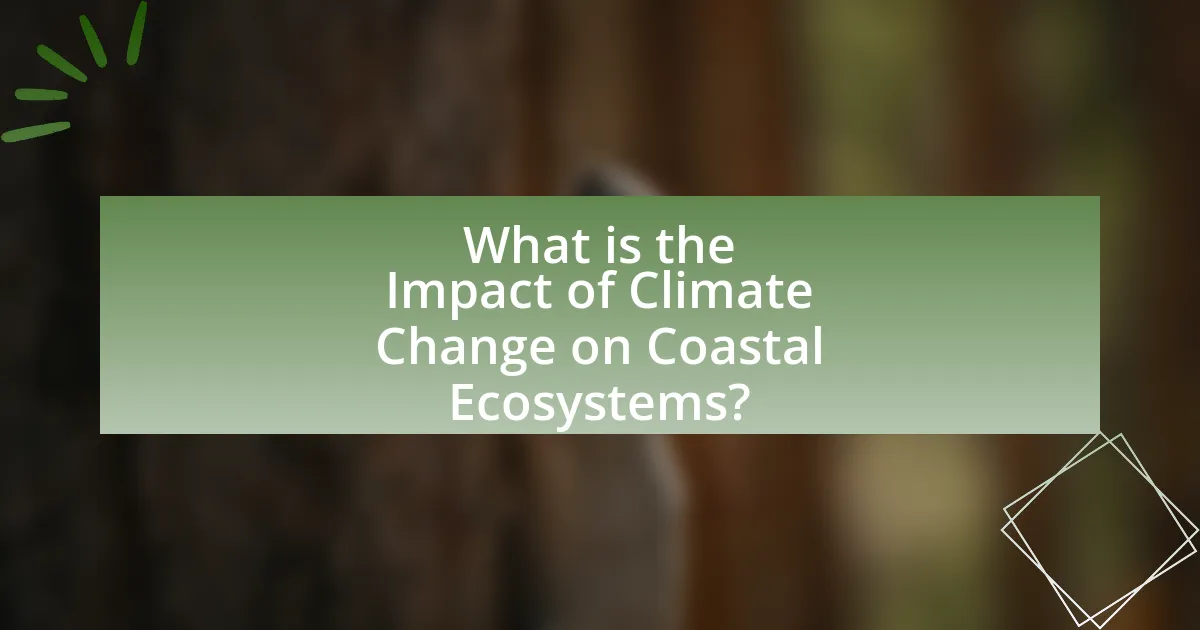
What is the Impact of Climate Change on Coastal Ecosystems?
Climate change significantly impacts coastal ecosystems by causing sea level rise, increased ocean temperatures, and ocean acidification. Sea level rise threatens habitats such as mangroves and salt marshes, which are crucial for biodiversity and coastal protection. Increased ocean temperatures lead to coral bleaching, affecting coral reefs that support diverse marine life. Ocean acidification, resulting from higher carbon dioxide levels, disrupts the ability of shellfish and other marine organisms to form shells, impacting food webs and fisheries. Studies indicate that by 2100, sea levels could rise by up to 1 meter, further endangering coastal ecosystems and the services they provide.
How does climate change affect coastal ecosystems?
Climate change significantly affects coastal ecosystems by altering their physical and biological processes. Rising sea levels, driven by melting ice caps and thermal expansion of seawater, lead to habitat loss for species such as mangroves and salt marshes, which are crucial for coastal protection and biodiversity. Additionally, increased ocean temperatures contribute to coral bleaching, threatening coral reefs that support diverse marine life. According to the Intergovernmental Panel on Climate Change (IPCC), by 2100, sea levels could rise by up to 1 meter, severely impacting coastal habitats and the species that rely on them. Furthermore, ocean acidification, a result of increased carbon dioxide absorption, disrupts the calcification processes of shellfish and other marine organisms, further destabilizing these ecosystems.
What are the primary factors of climate change influencing coastal areas?
The primary factors of climate change influencing coastal areas include rising sea levels, increased ocean temperatures, and ocean acidification. Rising sea levels, driven by the melting of polar ice caps and glaciers, threaten coastal habitats and increase the risk of flooding in low-lying regions. Increased ocean temperatures lead to coral bleaching and disrupt marine ecosystems, affecting biodiversity and fisheries. Ocean acidification, resulting from higher carbon dioxide levels, negatively impacts shellfish and other marine organisms that rely on calcium carbonate for their shells, further destabilizing coastal ecosystems. These factors collectively contribute to habitat loss, altered species distributions, and increased vulnerability of coastal communities.
How do rising sea levels impact coastal habitats?
Rising sea levels significantly impact coastal habitats by inundating land, leading to habitat loss and changes in species composition. As sea levels rise, saltwater intrudes into freshwater ecosystems, altering the salinity levels that many coastal species depend on for survival. For instance, the National Oceanic and Atmospheric Administration (NOAA) reports that a one-meter rise in sea level can result in the loss of up to 50% of coastal wetlands, which serve as critical habitats for various wildlife. Additionally, increased flooding and erosion can destroy nesting sites for birds and other species, further threatening biodiversity in these areas.
Why is understanding the impact of climate change on coastal ecosystems important?
Understanding the impact of climate change on coastal ecosystems is crucial because these ecosystems provide essential services, such as habitat for marine life, protection against storms, and carbon sequestration. Coastal ecosystems, including mangroves, salt marshes, and coral reefs, are highly vulnerable to climate change effects like sea-level rise, ocean acidification, and increased storm intensity. For instance, according to the Intergovernmental Panel on Climate Change (IPCC), sea-level rise could inundate up to 1.5 million coastal homes by 2100, threatening biodiversity and human livelihoods. Therefore, comprehending these impacts is vital for effective conservation strategies and policy-making to mitigate risks and enhance resilience in coastal regions.
What role do coastal ecosystems play in global biodiversity?
Coastal ecosystems are crucial for global biodiversity as they provide habitat for a diverse range of species, including fish, birds, and invertebrates. These ecosystems, such as mangroves, salt marshes, and coral reefs, support approximately 50% of the world’s marine species and serve as breeding and nursery grounds for many commercially important fish species. Additionally, coastal ecosystems contribute to nutrient cycling and carbon sequestration, which are vital for maintaining ecological balance. Studies indicate that the loss of these ecosystems could lead to a significant decline in biodiversity, with estimates suggesting that up to 70% of coastal species could be at risk due to habitat degradation and climate change impacts.
How do coastal ecosystems contribute to human livelihoods?
Coastal ecosystems contribute to human livelihoods by providing essential resources such as fish, shellfish, and other marine products that support local economies and food security. These ecosystems, including mangroves, coral reefs, and estuaries, serve as critical habitats for various species, which are vital for commercial and subsistence fishing. For instance, according to the Food and Agriculture Organization, approximately 40% of the world’s population lives within 100 kilometers of the coast, relying on these ecosystems for their livelihoods. Additionally, coastal ecosystems offer services such as tourism and recreation, which generate significant income and employment opportunities in coastal communities.
What are the key indicators of climate change effects on coastal ecosystems?
Key indicators of climate change effects on coastal ecosystems include rising sea levels, increased ocean temperatures, ocean acidification, and changes in species distribution. Rising sea levels, driven by melting ice caps and thermal expansion, threaten coastal habitats such as mangroves and salt marshes. Increased ocean temperatures disrupt marine life, leading to coral bleaching and altered breeding patterns. Ocean acidification, resulting from higher CO2 levels, negatively impacts shellfish and coral growth. Changes in species distribution, influenced by shifting temperature and salinity, can lead to the decline of native species and the introduction of invasive species, further destabilizing these ecosystems.
What changes in species distribution are observed in coastal areas?
Changes in species distribution observed in coastal areas include shifts towards higher latitudes and elevations as species adapt to rising temperatures. For instance, marine species such as fish and invertebrates are moving northward in response to warmer ocean temperatures, with studies indicating that species like the Atlantic mackerel have shifted their range by over 1,000 kilometers in the past few decades. Additionally, coastal habitats such as salt marshes and mangroves are experiencing changes in species composition, with some species declining while others, often more resilient to climate change, become more prevalent. This redistribution is further influenced by factors such as sea level rise, which alters habitat availability and salinity levels, impacting the overall biodiversity in these ecosystems.
How do alterations in water temperature affect coastal marine life?
Alterations in water temperature significantly affect coastal marine life by disrupting ecosystems and altering species distributions. For instance, warmer water temperatures can lead to coral bleaching, which occurs when corals expel the symbiotic algae they rely on for nutrition, resulting in increased mortality rates among coral reefs. Research indicates that a temperature rise of just 1-2 degrees Celsius can trigger this phenomenon, threatening biodiversity and the livelihoods of communities dependent on these ecosystems. Additionally, changes in temperature can affect the breeding and migration patterns of fish species, leading to shifts in population dynamics and potential declines in fish stocks. Studies have shown that species such as cod and haddock are moving northward in search of cooler waters, which can disrupt local fishing industries and food webs.
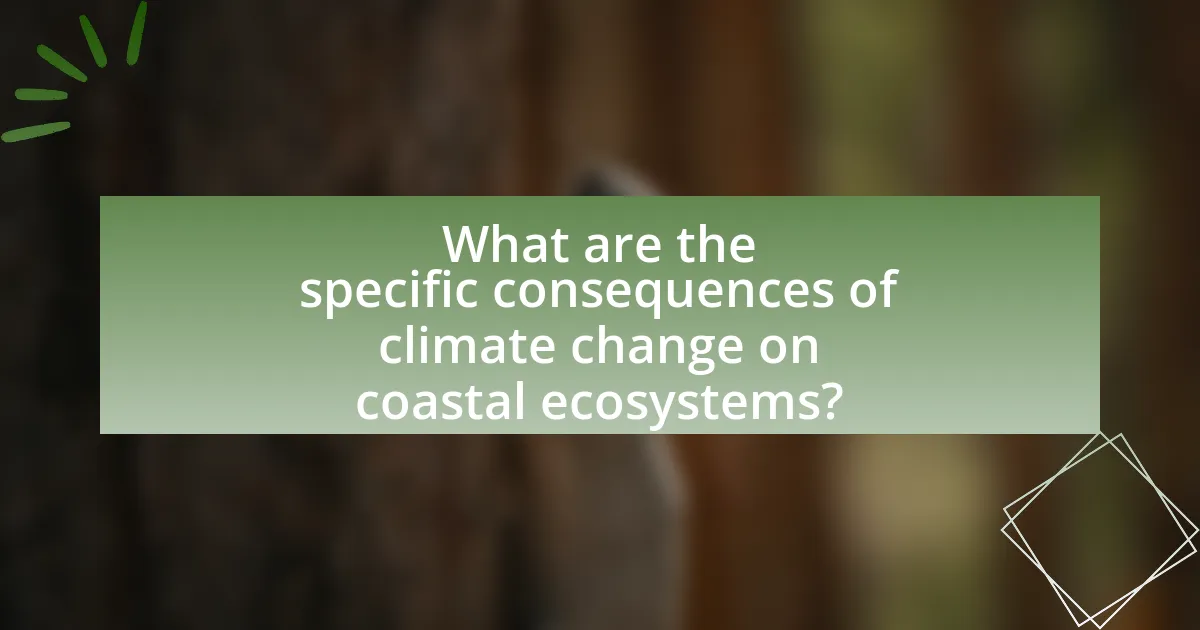
What are the specific consequences of climate change on coastal ecosystems?
Climate change leads to significant consequences for coastal ecosystems, including habitat loss, increased erosion, and altered species distributions. Rising sea levels inundate coastal habitats such as mangroves and salt marshes, reducing their area and ecological functions. Increased ocean temperatures contribute to coral bleaching, which threatens coral reefs, vital for marine biodiversity. Additionally, ocean acidification affects shellfish and other calcifying organisms, disrupting food webs. According to the Intergovernmental Panel on Climate Change (IPCC), these changes can lead to a decline in biodiversity and the services coastal ecosystems provide, such as storm protection and carbon sequestration.
How does ocean acidification impact coastal marine species?
Ocean acidification negatively impacts coastal marine species by reducing the availability of carbonate ions, which are essential for calcifying organisms like shellfish and corals to build their shells and skeletons. As atmospheric CO2 levels rise, more CO2 dissolves in ocean water, leading to a decrease in pH levels. This change in chemistry can result in slower growth rates, increased mortality, and altered behavior in species such as oysters, clams, and corals. For instance, studies have shown that elevated CO2 levels can decrease the calcification rates of corals by up to 40%, significantly affecting reef ecosystems and the biodiversity they support.
What are the effects of acidification on coral reefs?
Acidification negatively affects coral reefs by reducing their ability to calcify, which is essential for building their calcium carbonate structures. As atmospheric CO2 levels rise, more carbon dioxide dissolves in ocean water, leading to lower pH levels. This decrease in pH impairs the availability of carbonate ions, which are crucial for coral growth and maintenance. Research indicates that a 0.3 to 0.4 unit drop in pH can reduce calcification rates in corals by up to 30%. Additionally, acidification can weaken coral skeletons, making them more susceptible to erosion and disease, ultimately threatening the biodiversity and resilience of coral reef ecosystems.
How does acidification influence shellfish populations?
Acidification negatively influences shellfish populations by reducing their ability to form shells and maintain structural integrity. This occurs because increased carbon dioxide levels in the atmosphere lead to higher concentrations of carbonic acid in ocean waters, which lowers pH levels. Research indicates that lower pH impairs the calcification process in shellfish such as oysters, clams, and mussels, making them more vulnerable to predation and environmental stressors. For instance, a study published in the journal “Nature Climate Change” by Kroeker et al. (2013) found that acidification can decrease shell growth rates by up to 50% in some species, significantly impacting their survival and reproductive success.
What are the implications of increased storm intensity on coastal ecosystems?
Increased storm intensity negatively impacts coastal ecosystems by causing habitat destruction, erosion, and altered salinity levels. These storms can lead to the loss of critical habitats such as mangroves and salt marshes, which serve as nurseries for various marine species. For instance, a study published in the journal “Nature Climate Change” indicates that stronger storms can increase coastal erosion rates by up to 50%, significantly reducing the area of these vital ecosystems. Additionally, the influx of freshwater from heavy rainfall can disrupt the salinity balance in estuaries, affecting species that rely on stable salinity levels for survival. This disruption can lead to declines in fish populations and other marine life, ultimately impacting biodiversity and the health of coastal ecosystems.
How do stronger storms affect coastal erosion?
Stronger storms significantly increase coastal erosion by intensifying wave action and storm surges that erode shorelines. Research indicates that the frequency and intensity of storms have risen due to climate change, leading to greater coastal vulnerability. For instance, a study published in the journal “Nature Climate Change” found that rising sea levels and increased storm intensity can lead to erosion rates that are two to three times higher than historical averages. This accelerated erosion threatens coastal habitats, infrastructure, and ecosystems, demonstrating the direct impact of stronger storms on coastal erosion.
What is the impact of storm surges on coastal habitats?
Storm surges significantly disrupt coastal habitats by inundating land, altering salinity levels, and damaging vegetation. These surges can lead to the erosion of shorelines, loss of wetlands, and destruction of critical habitats for species such as fish, birds, and invertebrates. For instance, a study published in the journal “Estuarine, Coastal and Shelf Science” found that storm surges can result in a 50% reduction in the area of salt marshes, which serve as vital nurseries for marine life. Additionally, the increased salinity from storm surges can adversely affect freshwater species and disrupt the ecological balance of coastal ecosystems.
How does habitat loss due to climate change affect coastal biodiversity?
Habitat loss due to climate change significantly reduces coastal biodiversity by altering ecosystems and diminishing species populations. As sea levels rise and temperatures increase, critical habitats such as mangroves, salt marshes, and coral reefs are degraded or destroyed, leading to a decline in the variety of species that these ecosystems support. For instance, a study published in the journal “Nature” found that coral reefs, which are home to approximately 25% of all marine species, are projected to decline by 70-90% by 2050 if current climate trends continue. This loss of habitat not only threatens individual species but also disrupts food webs and ecological interactions, ultimately compromising the resilience of coastal ecosystems.
What specific habitats are most at risk from climate change?
Coastal habitats, including mangroves, salt marshes, and coral reefs, are most at risk from climate change. These ecosystems face threats such as rising sea levels, increased ocean temperatures, and ocean acidification, which can lead to habitat loss and decreased biodiversity. For instance, coral reefs are particularly vulnerable, with studies indicating that a temperature rise of just 1-2 degrees Celsius can cause widespread coral bleaching, impacting marine life that depends on these structures for survival. Additionally, mangroves and salt marshes are being eroded due to rising sea levels, which can result in the loss of critical coastal protection and carbon storage capabilities.
How does habitat loss influence species extinction rates?
Habitat loss significantly increases species extinction rates by reducing the available living space and resources necessary for survival. When ecosystems are altered or destroyed, such as through coastal development or climate change, species face challenges like food scarcity, decreased breeding grounds, and increased competition. According to the International Union for Conservation of Nature (IUCN), habitat loss is a primary driver of extinction, with over 80% of species at risk due to habitat degradation. This statistic underscores the direct correlation between habitat loss and the heightened vulnerability of species to extinction.
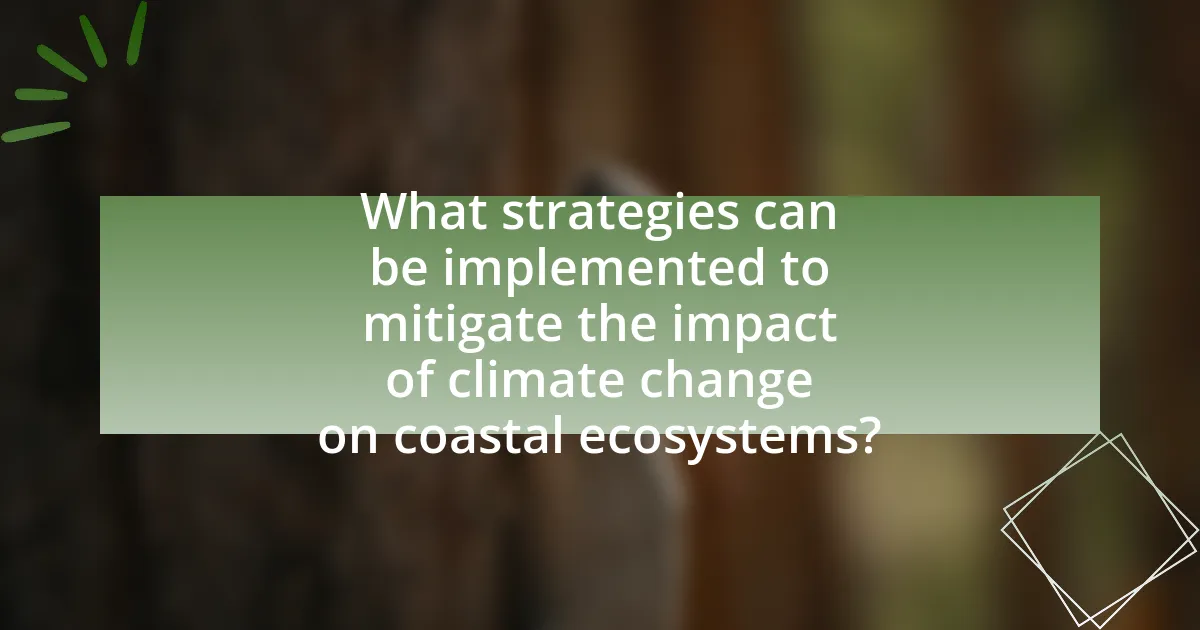
What strategies can be implemented to mitigate the impact of climate change on coastal ecosystems?
To mitigate the impact of climate change on coastal ecosystems, strategies such as restoring mangroves, implementing sustainable fisheries management, and enhancing coastal protection through natural barriers can be employed. Restoring mangroves has been shown to reduce coastal erosion and provide habitat for marine species, with studies indicating that mangrove restoration can sequester up to 1.5 billion tons of carbon annually. Sustainable fisheries management helps maintain fish populations and ecosystem balance, which is crucial as overfishing exacerbates the effects of climate change. Additionally, enhancing coastal protection through natural barriers like wetlands and dunes can buffer against storm surges and rising sea levels, with evidence suggesting that healthy wetlands can reduce flood damage by up to 30%. These strategies collectively contribute to the resilience of coastal ecosystems in the face of climate change.
What are effective conservation practices for coastal ecosystems?
Effective conservation practices for coastal ecosystems include the establishment of marine protected areas (MPAs), restoration of natural habitats, and sustainable fisheries management. MPAs help preserve biodiversity by restricting harmful activities, with studies showing that they can increase fish populations by up to 600% in some regions. Habitat restoration, such as replanting mangroves and seagrasses, enhances coastal resilience against climate change impacts, as these ecosystems can absorb significant amounts of carbon dioxide and reduce coastal erosion. Sustainable fisheries management ensures that fish stocks remain healthy, which is crucial for maintaining the ecological balance and supporting local economies. These practices collectively contribute to the health and sustainability of coastal ecosystems in the face of climate change.
How can restoration projects help in mitigating climate change effects?
Restoration projects can mitigate climate change effects by enhancing carbon sequestration and improving ecosystem resilience. For instance, restoring coastal wetlands can sequester significant amounts of carbon dioxide, with studies indicating that mangroves can store up to four times more carbon per hectare than terrestrial forests. Additionally, these projects help protect shorelines from erosion and flooding, which are exacerbated by climate change. Research shows that restored ecosystems can better withstand extreme weather events, thereby reducing the overall impact of climate change on coastal areas.
What role do protected areas play in preserving coastal ecosystems?
Protected areas play a crucial role in preserving coastal ecosystems by providing a safe environment that mitigates the impacts of climate change, habitat loss, and human activities. These designated regions help maintain biodiversity, protect critical habitats such as mangroves and coral reefs, and enhance resilience against climate-related stressors. For instance, studies have shown that marine protected areas can lead to a 20-50% increase in fish populations, which supports ecosystem health and stability. Additionally, protected areas serve as vital buffers against coastal erosion and flooding, further safeguarding both natural and human communities.
How can communities adapt to the impacts of climate change on coastal areas?
Communities can adapt to the impacts of climate change on coastal areas by implementing strategies such as building resilient infrastructure, restoring natural habitats, and enhancing community preparedness. For instance, elevating buildings and roads can reduce flood risks, while restoring mangroves and wetlands can provide natural barriers against storm surges and erosion. According to the National Oceanic and Atmospheric Administration (NOAA), investing in green infrastructure can significantly mitigate the effects of climate change, as natural systems often provide more effective protection than engineered solutions. Additionally, community engagement in disaster preparedness and response planning is crucial, as studies show that informed communities are better equipped to handle climate-related challenges.
What are some community-based adaptation strategies?
Community-based adaptation strategies include the implementation of mangrove restoration, the establishment of community-managed marine protected areas, and the promotion of sustainable fishing practices. These strategies are designed to enhance resilience against climate change impacts on coastal ecosystems. For instance, mangrove restoration has been shown to reduce coastal erosion and provide habitat for diverse marine species, thereby supporting local fisheries and biodiversity. Additionally, community-managed marine protected areas empower local populations to sustainably manage their resources, leading to improved fish stocks and ecosystem health. Sustainable fishing practices, such as seasonal closures and gear restrictions, further contribute to the long-term viability of fish populations, ensuring food security for coastal communities.
How can local governments support coastal resilience initiatives?
Local governments can support coastal resilience initiatives by implementing policies that promote sustainable land use and invest in infrastructure improvements. For instance, they can adopt zoning regulations that prevent development in high-risk flood zones, thereby reducing vulnerability to storm surges and sea-level rise. Additionally, local governments can allocate funding for the restoration of natural barriers, such as wetlands and mangroves, which provide critical protection against coastal erosion and flooding. Research indicates that investing in natural infrastructure can yield a return of up to $4 for every $1 spent on restoration efforts, highlighting the economic benefits of such initiatives.
What are the best practices for sustainable coastal management?
The best practices for sustainable coastal management include integrated coastal zone management (ICZM), habitat restoration, and stakeholder engagement. ICZM promotes a holistic approach that considers environmental, economic, and social factors, ensuring that coastal development is balanced with conservation efforts. Habitat restoration, such as replanting mangroves and restoring wetlands, enhances biodiversity and protects shorelines from erosion. Engaging stakeholders, including local communities and businesses, fosters collaboration and ensures that diverse perspectives are considered in decision-making processes. These practices are supported by evidence showing that regions implementing ICZM have seen improved ecological health and resilience against climate change impacts, as highlighted in the United Nations Environment Programme’s reports on coastal ecosystems.
How can integrated coastal zone management enhance ecosystem resilience?
Integrated coastal zone management enhances ecosystem resilience by promoting sustainable practices that balance ecological health with human activities. This approach facilitates the protection of coastal habitats, such as mangroves and wetlands, which serve as natural buffers against climate change impacts like sea-level rise and storm surges. Research indicates that areas with effective integrated coastal zone management show improved biodiversity and ecosystem services, which are critical for maintaining resilience. For instance, a study published in the journal “Ocean & Coastal Management” found that regions implementing integrated management strategies experienced a 30% increase in habitat stability compared to unmanaged areas. This evidence underscores the effectiveness of integrated coastal zone management in strengthening the resilience of coastal ecosystems against climate change.
What role does public awareness play in coastal ecosystem protection?
Public awareness plays a crucial role in coastal ecosystem protection by fostering community engagement and promoting sustainable practices. Increased awareness leads to informed public support for conservation initiatives, which can result in policy changes and funding for ecosystem restoration. For instance, studies show that communities with higher levels of environmental education are more likely to participate in local conservation efforts, such as beach clean-ups and habitat restoration projects. This engagement not only enhances the effectiveness of conservation strategies but also helps to mitigate the impacts of climate change on coastal ecosystems by encouraging responsible behaviors that reduce pollution and habitat destruction.
What practical steps can individuals take to support coastal ecosystems?
Individuals can support coastal ecosystems by participating in local conservation efforts, such as beach clean-ups and habitat restoration projects. Engaging in these activities helps remove debris that harms marine life and restores natural habitats, which are crucial for biodiversity. According to the National Oceanic and Atmospheric Administration (NOAA), community involvement in coastal restoration can significantly enhance the resilience of these ecosystems against climate change impacts. Additionally, individuals can reduce their carbon footprint by using public transportation, conserving energy, and supporting sustainable seafood practices, which collectively contribute to mitigating climate change effects on coastal areas.
